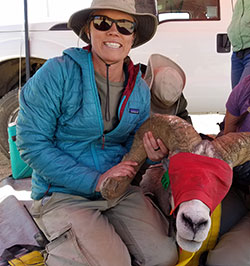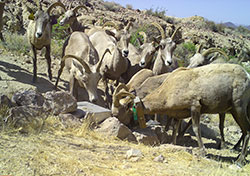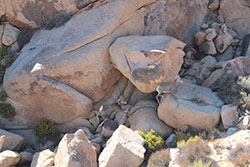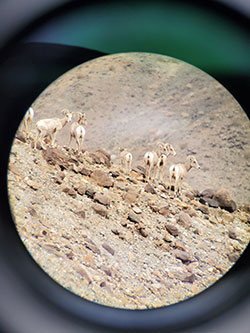Featured Scientist Paige Prentice with her dog Yuba.

Paige Prentice with ram captured and collared in the Mojave National Preserve. Click to enlarge

A group of ewes drink from a wildlife water source in the Marble Mountains. This photo was taken by a motion-activated trail camera. Click to enlarge

A photo taken during a helicopter survey shows a ewe and a yearling ram (male bighorn) in the Granite Mountains. Click to enlarge

A group of ewes (female bighorn) with a lamb in Afton Canyon (San Bernardino County) as seen through a spotting scope. Click to enlarge
Wildlife biologist Paige Prentice grew up surrounded by trees in Nevada City, California, and knew she had selected the right college when she saw all the redwoods on the campus of UC Santa Cruz. But it was a seasonal job after college in Death Valley National Park that spawned her love of the desert, and today she is a Desert Bighorn Sheep Biologist with CDFW, based in Inyo County. Paige loves learning, evidenced by degrees in Ecology and Evolutionary Biology, and Anthropology at UCSC. Currently, she is working on her master’s degree in Wildlife Science through Oregon State University.
Do you remember when you first became so interested in science you realized it might become your career?
When I was a little kid, I used to tell people that I wanted to study elephants and gorillas. After college I had the opportunity to spend six months studying orangutans on the Island of Borneo in Indonesia. And while that was an awesome once-in-a-lifetime experience, I learned that I wanted to focus on species a little closer to home. Growing up, my folks were the type of people that would drive through deserts and say, “it’s just hot and dry and there’s nothing here.” I believed them, until I was 24 and I got a job in Death Valley as an AmeriCorps intern with the Park Service. It was then that fell in love with the desert. I was mesmerized by the expansive landscapes and amazed by how much life the desert supported. I was hired as a scientific aide with CDFW nearly six years ago when a position opened on the desert bighorn crew.
Why does CDFW dedicate staff to Desert Bighorn Sheep specifically?
Well first, you have to understand that in California we have three separately managed bighorn populations. Two populations are endangered and managed under their own recovery programs—the Sierra Nevada bighorn sheep and the peninsular bighorn sheep (San Diego, Riverside and Imperial counties). Then, there is the broad grouping of desert bighorn sheep which are not endangered—these are the ones I focus on. Because the two recovery programs have their own focused teams, I think it set a precedent for my position to focus solely on desert bighorn. That said, because there are over 50 mountain ranges with desert bighorn and we’re interested in questions at both the population and metapopulation level, it makes sense to have a desert bighorn sheep specific program.
As a bighorn sheep biologist, what are you studying? What are you looking at when trying to manage that population?
Great question. There is a lot to study, given that we are looking at over 50 distinct populations across a large geographic area that is fragmented by major interstates. On a broad scale, we’re looking at which mountain ranges have bighorn in them, how many animals are in each population and how the populations are connected to one another. We conduct ground, camera, and helicopter surveys to document age and sex ratios and recruitment (lambs surviving to adulthood). We capture and collar animals to track movements, monitor survival and to test for disease. We are interested in what type of diseases are present and what the short- and long-term impacts are. We also have artificial and natural water sources in the desert, and we work with NGOs, like the Society for the Conservation of Bighorn Sheep, to makes sure these sources are maintained and stay full of water.
We put out water for these animals?
It is a lot more complicated than “putting water out for them,” but yes, for the last 50 years, CDFW, with the help of NGOs, has built, maintained and repaired artificial water sources in many mountain ranges across the desert. With climate change and prolonged droughts, animals that used to just rely on water sources during the hot summer months are relying on these water sources year-round. Under normal conditions, bighorn sheep get most of the water they need from October to April from the forage that they eat. But during prolonged drought periods, the forage quality is poorer and has less water content, which forces animals to drink surface water. Furthermore, natural springs are drying up and/or becoming less reliable. In many of these ranges, artificial water sources appear to help stabilize these populations during otherwise variable conditions. If climate change continues to drive drought conditions in the desert, these water needs will likely continue and even increase.
What else does the department do to help these populations?
We use the data we collect to protect key movement corridors between populations. This involves working with different land management agencies and stakeholders to provide input and feedback on new projects and installations, such as high-speed trains and alternative energy projects.
In addition, education and outreach is our main tool to help reduce the spread of disease to bighorn populations. One of the biggest threats to bighorn sheep are diseases from domestic livestock, like sheep and goats. Just like with humans, if you have a population that is unexposed to certain diseases, new exposures can have serious effects. Domestic sheep owners can reduce risk to wild populations if their animals are well-fenced and they establish a 10-ft. buffer to keep wild sheep separate from their domestic animals. It is important for CDFW to develop strong relationships with the public, so they feel like partners in protecting wild bighorn populations. If a domestic sheep escapes into bighorn sheep habitat, the best thing the public can do is to notify CDFW so we can capture the domestic animal quickly.
Aren’t there times we capture sheep as well, shooting nets on them from helicopters?
Yes, we generally capture bighorn using a helicopter with a netgun. Thankfully, we’re not the ones that are flying for captures– we hire professionals for that. We conduct captures in the fall and this past November we captured and collared 100 animals across eight populations. It is a team effort and certainly a lot of work. I think some folks hear about the captures and think, “why capture wild animals?” But in fact, the work we do with captures provides the majority of the data we have to help protect these magnificent creatures.
What is it you like about bighorn sheep?
They completely captivate me. I am aware of very few species that are experts of such extreme environments. Within California, there are desert bighorn that live above 14,000 feet and navigate snow in the wintertime. A hundred miles to the south, there are animals in Death Valley that are living below sea level and are experiencing temperatures of over 125 degrees in the summer. When you track these animals and spend time in the landscapes in which they flourish, you can’t help but respect them. They are also one of the most graceful animals I have ever seen—watching them move with ease, at top speed up mountain sides is stunningly impressive.
What don't we know about bighorn sheep?
There are a lot of things we’re still learning. One of the big questions we're trying to understand is, what drives different responses to the same strain of pneumonia? If we can understand these drivers, perhaps we can help make these populations more robust and less susceptible to disease.
Changing gears a bit, if you weren't doing this, what would you be doing?
I laugh when people ask that. I am the type of person that tries to fit 36 hours into 24. I always have an endless list of things to do, and I rarely sit still—so I’m sure I would keep myself busy. I am an outdoor enthusiast, I love to travel, and I deeply value spending quality time with my family and friends. But career-wise, it is hard to say. Ten years ago, bighorn sheep weren’t even on my radar and now I’m working this dream job. I still consider myself to be an anthropologist. I am intrigued by the world of medicine. I am concerned about the environment. To me, the important part is that I am incredibly grateful for the for the opportunity to be pursuing my master’s degree, while working a job that I am passionate about, with a team that I deeply respect—that’s hard to beat.
Being an outdoor enthusiast, what’s a fun day like for you over in Bishop?
I live my life with the motto: work hard, play hard. Before work this morning, I went for a mountain bike ride. I love hiking and getting in the mountains with my dog. My newest hobbies include kayaking and kitesurfing. I love multi-day rafting trips and exploring new places with friends. If I have an excuse to get outdoors, I’ll take it.
CDFW photos